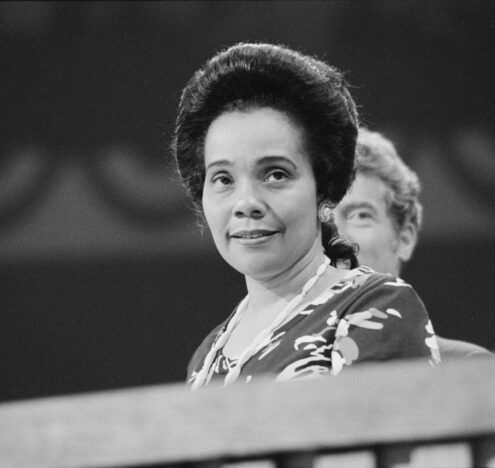Immigration debates have been central to American politics for decades and as levels of international migration continue to steadily increase, so does its political salience. Yet, immigration, for all its military, economic, diplomatic, and humanitarian implications, has rarely been conceptualized as a foreign policy problem. Instead, it’s often regarded as an issue of national security that begins and ends at our borders. This trend of dealing with migration on the back-end is a band-aid solution for the global wound of forced migration.
Although Vice President Kamala Harris’ summer trip to Latin America prompted intense backlash from all sides, lost amidst the scrutiny was an important message: Most people who migrate from low-income countries do not want to leave their homes, and would not do so if they felt safe and economically secure. Over the past year, there have been some hopeful signs that this administration might finally start approaching the immigration issue through a more nuanced lens, such as increasing the refugee quota and emphasizing messaging around the “root causes” of migration trends.
Acknowledging that most migration is forced is a good start because it gets at the idea that tackling the immigration issue requires addressing emigration pressures. In order to do this effectively, however, the Biden administration needs to think of migration as a foreign policy issue, and not just a domestic problem or national security priority.
THE POWER OF CHOICE
One of the things that impedes our political imagination, much less our federal institutions, from shifting focus to grappling with the “push” factors that fuel global migration as foreign policy priorities is at least partly attributable to the arbitrary and politically expedient distinction between “refugees” and “economic migrants.” For those who don’t have the resources or ability to navigate the selective, complicated, and costly channels of legal migration that vary widely from country to country, what separates legal entry from illegal entry is boiled down to a single, over-simplistic element: Choice.
A closer look into the lived experiences of millions of immigrants shows that often, it is near impossible to distinguish between security and economic reasons for migration.
Differentiating among different types of migrants serves to ensure that those most impacted by war and persecution are given immediate priority access to safe and legal mechanisms of migration. In the face of increasing political salience around the immigration issue and rising hostility toward refugees and migrants alike, there is no question that the inclination to separate people who need to migrate to survive from those choosing to migrate is rooted in goodwill. However, these categories reflect a reductive dichotomy between economic and security reasons to migrate, when in reality, these factors are inextricably connected. In other words, the idea that economic security isn’t directly related to survival has contributed to a false binary of those deserving and those undeserving of the right to migrate.
In 2020, international migrants represented around 3.6% of the global population — that is around 280 million people estimated to live in a different country than the one they were born in, and global migration trends are expected to continue rising. Yet, of this staggering figure only an estimated 10% of international migrants were categorized as refugees, implying that 90% of people making journeys across borders did so simply because they felt like it.
Reality is simply not this black and white. A closer look into the lived experiences of millions of immigrants shows that often, it is near impossible to distinguish between security and economic reasons for migration. For example, in Guatemala, indigenous farmers were stripped of their livelihoods and driven off their land to make way for agro-industry producing sugar and biofuels, and with links to the US and US-market demand. Yet, the land grabs were done by active or retired militants deeply involved with organized crime, raising concerns about the links between US corporations and forced migration.
As climate change increases the frequency and severity of forces of destruction, such as tropical storms, floods, droughts, and other natural disasters, this emerging agent of displacement disproportionately impacts poor people living in low-income countries. Stories of families whose homes were washed away by hurricanes in Bangladesh or communities whose food and income sources were dried up by droughts in rural Guatemala or those who are in the midst of violent conflict occurring as a direct result of dramatically shrinking water sources, as is the case in Nigeria, Chad, Niger, and Cameroon, all indicate that climate migrants face no choice but to move when their homes become uninhabitable and their livelihoods unviable.
For migrants fleeing starvation, the difference between being considered a refugee or economic migrant depends entirely on external classification of humanitarian crisis. So while hunger crises force people every day to choose between migration and death across various contexts from South Sudan to Afghanistan to Venezuela and Honduras, not all will be eligible for refugee status. Many migrants will continue to be excluded from international protection until it’s understood that economic security is directly related to survival. So, even when migrants may not be able to prove that they are directly persecuted or targeted, their decision to migrate is still one made for survival.
WHY MIGRATION IS A FOREIGN POLICY ISSUE
Approaching immigration through the lens of foreign policy gets ahead of the issue by accounting for “push” factors that drive people from their homelands. This approach considers the conditions that underlie migration flows, with a focus on displaced populations, human rights norms, and institutions and cooperation among states. Put simply, forced migration is not simply a domestic problem or national security priority because it does not end at borders — and it certainly doesn’t end at the US border. The Biden administration, therefore, must recognize forced migration as a US foreign policy priority. Why? The answer is surprisingly simple.
The US has been and continues to be one of the destination countries receiving the highest inflows of migrants driven from their homelands and is a global power with the resources and ability to intervene on many of the “push” factors that shape forced migration. For Latin America, the drug war and US-backed authoritarian regimes makes the link between US foreign policy and the structural conditions underlying current dangerous migratory cycles obvious. US foreign policy in Latin America, therefore, has impacted the region’s migratory cycles.
In the face of climate change-driven displacement and violent-conflict driven-migration, the US shares a collective interest in addressing these global challenges. More importantly, the US faces the responsibility for accounting for its role in fueling both climate change and violent conflict. The US has both directly and indirectly contributed to these agents of displacement in many ways. For example, the US has exported military-grade weapons to conflict zones, creating instability that has led thousands to flee in places like Yemen and Lebanon. US sanctions and tariffs have also perpetuated global economic inequality, resulting in people fleeing failing economies, such as is currently happening in Venezuela and Cuba.
The impact of US foreign policy, therefore, has had implications across the globe, especially when it comes to migration. Directly and indirectly, US foreign policy is playing a role in why people are fleeing from their homes.
A CASE FOR RECOGNITION
December 18 is International Day of the Migrants, which was instituted by the UN to raise awareness about the challenges and difficulties of international migration, making today a prime opportunity to challenge the notion that economic and security reasons for migration are mutually exclusive.
People who make treacherous journeys within and across borders would not do so if they felt they had a choice. The recognition that forced migration happens much more broadly than currently acknowledged in immigration debates will be essential to shaping a political climate in which international development, climate action, cooperation, and peacebuilding are central to US foreign policy. Broadening understandings of forced migration to a foreign policy issue is essential for moving past the barriers that prevent the creation of practical policies. In other words, when it comes to immigration, it’s time to think outside the domestic box.
Elsie Mares is a 2021 Herbert Scoville Jr. Peace Fellow at Peace Direct. In this capacity, she works with the Policy and Advocacy team organizing Platform4Dialogue consultations, scoping and developing partnerships with local peacebuilders, and researching the intersection between migration and peacebuilding.




















